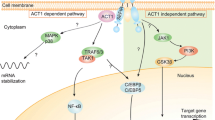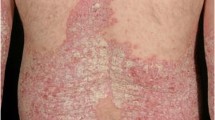Abstract
T helper (Th) 17 cells, a novel T-cell subset, have been implicated in the pathogenesis of psoriasis and other autoimmune inflammatory diseases. Interleukin (IL)-23 stimulates survival and proliferation of Th17 cells, and thus serves as a key master cytokine regulator for these diseases. In psoriasis, IL-23 is overproduced by dendritic cells and keratinocytes, and this cytokine stimulates Th17 cells within dermis to make IL-17A and IL-22. IL-22, in particular, drives keratinocyte hyperproliferation in psoriasis. Future targeting of these key cytokines is likely to lead to dramatic clinical improvement in patients with psoriasis. This review focuses on the numerous recent studies on the roles of IL-23 and Th17 cells in the pathogenesis of psoriasis.
Similar content being viewed by others
References and Recommended Reading
Schon MP, Boehncke WH: Psoriasis. N Engl J Med 2005, 352:1899–1912.
Lowes MA, Bowcock AM, Krueger JG: Pathogenesis and therapy of psoriasis. Nature 2007, 445:866–873.
Stockinger B, Veldhoen M: Differentiation and function of Th17 T cells. Curr Opin Immunol 2007, 19:281–286.
Blauvelt A: New concepts in the pathogenesis and treatment of psoriasis: key roles for IL-23, IL-17A and TGF-beta1. Expert Rev Dermatol 2007, 2:1–10.
Bettelli E, Carrier Y, Gao W, et al.: Reciprocal developmental pathways for the generation of pathogenic effector TH17 and regulatory T cells. Nature 2006, 441:235–238.
Mangan PR, Harrington LE, O’Quinn DB, et al.: Transforming growth factor-beta induces development of the T(H)17 lineage. Nature 2006, 441:231–234.
Ivanov, II, McKenzie BS, Zhou L, et al.: The orphan nuclear receptor RORgamma-t directs the differentiation program of proinflammatory IL-17+ T helper cells. Cell 2006, 126:1121–1133.
Nurieva R, Yang XO, Martinez G, et al.: Essential autocrine regulation by IL-21 in the generation of inflammatory T cells. Nature 2007, 448:480–483.
Acosta-Rodriguez EV, Napolitani G, Lanzavecchia A, Sallusto F: Interleukins 1beta and 6 but not transforming growth factor-beta are essential for the differentiation of interleukin 17-producing human T helper cells. Nat Immunol 2007, 8:942–949.
Flisiak I, Chodynicka B, Porebski P, Flisiak R: Association between psoriasis severity and transforming growth factor beta1 and beta2 in plasma and scales from psoriatic lesions. Cytokine 2002, 19:121–125.
Nickoloff BJ, Naidu Y: Perturbation of epidermal barrier function correlates with initiation of cytokine cascade in human skin. J Am Acad Dermatol 1994, 30:535–546.
Li AG, Wang D, Feng XH, Wang XJ: Latent TGFbeta1 overexpression in keratinocytes results in a severe psoriasis-like skin disorder. Embo J 2004, 23:1770–1781.
Sano S, Chan KS, Carbajal S, et al.: Stat3 links activated keratinocytes and immunocytes required for development of psoriasis in a novel transgenic mouse model. Nat Med 2005, 11:43–49.
Oppmann B, Lesley R, Blom B, et al.: Novel p19 protein engages IL-12p40 to form a cytokine, IL-23, with biological activities similar as well as distinct from IL-12. Immunity 2000, 13:715–725.
Piskin G, Sylva-Steenland RM, Bos JD, Teunissen MB: In vitro and in situ expression of IL-23 by keratinocytes in healthy skin and psoriasis lesions: enhanced expression in psoriatic skin. J Immunol 2006, 176:1908–1915.
Acosta-Rodriguez EV, Rivino L, Geginat J, et al.: Surface phenotype and antigenic specificity of human interleukin 17-producing T helper memory cells. Nat Immunol 2007, 8:639–646.
LeibundGut-Landmann S, Gross O, Robinson MJ, et al.: Syk-and CARD9-dependent coupling of innate immunity to the induction of T helper cells that produce interleukin 17. Nat Immunol 2007, 8:630–638.
Re F, Strominger JL: Toll-like receptor 2 (TLR2) and TLR4 differentially activate human dendritic cells. J Biol Chem 2001, 276:37692–37699.
Higgins SC, Jarnicki AG, Lavelle EC, Mills KH: TLR4 mediates vaccine-induced protective cellular immunity to Bordetella pertussis: role of IL-17-producing T cells. J Immunol 2006, 177:7980–7989.
Chamian F, Lowes MA, Lin SL, et al.: Alefacept reduces infiltrating T cells, activated dendritic cells, and inflammatory genes in psoriasis vulgaris. Proc Natl Acad Sci U S A 2005, 102:2075–2080.
Chan JR, Blumenschein W, Murphy E, et al.: IL-23 stimulates epidermal hyperplasia via TNF and IL-20R2-dependent mechanisms with implications for psoriasis pathogenesis. J Exp Med 2006, 203:2577–2587.
Toichi E, Torres G, McCormick TS, et al.: An anti-IL-12p40 antibody down-regulates type 1 cytokines, chemokines, and IL-12/IL-23 in psoriasis. J Immunol 2006, 177:4917–4926.
Lee E, Trepicchio WL, Oestreicher JL, et al.: Increased expression of interleukin 23 p19 and p40 in lesional skin of patients with psoriasis vulgaris. J Exp Med 2004, 199:125–130.
Piskin G, Tursen U, Sylva-Steenland RM, et al.: Clinical improvement in chronic plaque-type psoriasis lesions after narrow-band UVB therapy is accompanied by a decrease in the expression of IFN-gamma inducers — IL-12, IL-18 and IL-23. Exp Dermatol 2004, 13:764–772.
Gottlieb AB, Chamian F, Masud S, et al.: TNF inhibition rapidly down-regulates multiple proinflammatory pathways in psoriasis plaques. J Immunol 2005, 175:2721–2729.
Lowes MA, Chamian F, Abello MV, et al.: Increase in TNF-alpha and inducible nitric oxide synthase-expressing dendritic cells in psoriasis and reduction with efalizumab (anti-CD11a). Proc Natl Acad Sci U S A 2005, 102:19057–19062.
Tsunemi Y, Saeki H, Nakamura K, et al.: Interleukin-12 p40 gene (IL12B) 3′-untranslated region polymorphism is associated with susceptibility to atopic dermatitis and psoriasis vulgaris. J Dermatol Sci 2002, 30:161–166.
Cargill M, Schrodi SJ, Chang M, et al.: A large-scale genetic association study confirms IL12B and leads to the identification of IL23R as psoriasis-risk genes. Am J Hum Genet 2007, 80:273–290.
Capon F, Di Meglio P, Szaub J, et al.: Sequence variants in the genes for the interleukin-23 receptor (IL23R) and its ligand (IL12B) confer protection against psoriasis. Hum Genet 2007, 122:201–206.
Nair RP, Stuart PE, Nistor I, et al.: Sequence and haplotype analysis supports HLA-C as the psoriasis susceptibility 1 gene. Am J Hum Genet 2006, 78:827–851.
Wiekowski MT, Leach MW, Evans EW, et al.: Ubiquitous transgenic expression of the IL-23 subunit p19 induces multiorgan inflammation, runting, infertility, and premature death. J Immunol 2001, 166:7563–7570.
Kopp T, Lenz P, Bello-Fernandez C, et al.: IL-23 production by cosecretion of endogenous p19 and transgenic p40 in keratin 14/p40 transgenic mice: evidence for enhanced cutaneous immunity. J Immunol 2003, 170:5438–5444.
Zheng Y, Danilenko DM, Valdez P, et al.: Interleukin-22, a T(H)17 cytokine, mediates IL-23-induced dermal inflammation and acanthosis. Nature 2007, 445:648–651.
Weaver CT, Hatton RD, Mangan PR, Harrington LE: IL-17 family cytokines and the expanding diversity of effector T cell lineages. Annu Rev Immunol 2007, 25:821–852.
Dong C: Diversification of T-helper-cell lineages: finding the family root of IL-17-producing cells. Nat Rev Immunol 2006, 6:329–333.
Shalom-Barak T, Quach J, Lotz M: Interleukin-17-induced gene expression in articular chondrocytes is associated with activation of mitogen-activated protein kinases and NF-kappaB. J Biol Chem 1998, 273:27467–27473.
Laan M, Cui ZH, Hoshino H, et al.: Neutrophil recruitment by human IL-17 via C-X-C chemokine release in the airways. J Immunol 1999, 162:2347–2352.
Starnes T, Broxmeyer HE, Robertson MJ, Hromas R: Cutting edge: IL-17D, a novel member of the IL-17 family, stimulates cytokine production and inhibits hemopoiesis. J Immunol 2002, 169:642–646.
Dragon S, Saffar AS, Shan L, Gounni AS: IL-17 attenuates the anti-apoptotic effects of GM-CSF in human neutrophils. Mol Immunol 2008, 45:160–168.
Numasaki M, Fukushi J, Ono M, et al.: Interleukin-17 promotes angiogenesis and tumor growth. Blood 2003, 101:2620–2627.
Jovanovic DV, Martel-Pelletier J, Di Battista JA, et al.: Stimulation of 92-kd gelatinase (matrix metalloproteinase 9) production by interleukin-17 in human monocyte/macrophages: a possible role in rheumatoid arthritis. Arthritis Rheum 2000, 43:1134–1144.
Ruddy MJ, Wong GC, Liu XK, et al.: Functional cooperation between interleukin-17 and tumor necrosis factor-alpha is mediated by CCAAT/enhancer-binding protein family members. J Biol Chem 2004, 279:2559–2567.
Albanesi C, Scarponi C, Cavani A, et al.: Interleukin-17 is produced by both Th1 and Th2 lymphocytes, and modulates interferon-gamma-and interleukin-4-induced activation of human keratinocytes. J Invest Dermatol 2000, 115:81–87.
Homey B, Dieu-Nosjean MC, Wiesenborn A, et al.: Up-regulation of macrophage inflammatory protein-3 alpha/CCL20 and CC chemokine receptor 6 in psoriasis. J Immunol 2000, 164:6621–6632.
Conrad C, Tonel G, Qin J, et al.: Functional dissection of interleukin-17 in the pathogenesis of psoriasis. J Invest Dermatol 2007, 127:S13.
Liang SC, Tan XY, Luxenberg DP, et al.: Interleukin (IL)-22 and IL-17 are coexpressed by Th17 cells and cooperatively enhance expression of antimicrobial peptides. J Exp Med 2006, 203:2271–2279.
Wolk K, Kunz S, Witte E, et al.: IL-22 increases the innate immunity of tissues. Immunity 2004, 21:241–254.
Boniface K, Bernard FX, Garcia M, et al.: IL-22 inhibits epidermal differentiation and induces proinflammatory gene expression and migration of human keratinocytes. J Immunol 2005, 174:3695–3702.
Wolk K, Witte E, Wallace E, et al.: IL-22 regulates the expression of genes responsible for antimicrobial defense, cellular differentiation, and mobility in keratinocytes: a potential role in psoriasis. Eur J Immunol 2006, 36:1309–1323.
Ong PY, Ohtake T, Brandt C, et al.: Endogenous antimicrobial peptides and skin infections in atopic dermatitis. N Engl J Med 2002, 347:1151–1160.
Zhou L, Ivanov II, Spolski R, et al.: IL-6 programs T(H)-17 cell differentiation by promoting sequential engagement of the IL-21 and IL-23 pathways. Nat Immunol 2007, 8:967–974.
Korn T, Bettelli E, Gao W, et al.: IL-21 initiates an alternative pathway to induce proinflammatory T(H)17 cells. Nature 2007, 448:484–487.
Brandt K, Singh PB, Bulfone-Paus S, Ruckert R: Interleukin-21: a new modulator of immunity, infection, and cancer. Cytokine Growth Factor Rev 2007, 18:223–232.
Annunziato F, Cosmi L, Santarlasci V, et al.: Phenotypic and functional features of human Th17 cells. J Exp Med 2007, 204:1849–1861.
Clark RA, Chong B, Mirchandani N, et al.: The vast majority of CLA+ T cells are resident in normal skin. J Immunol 2006, 176:4431–4439.
Krueger GG, Langley RG, Leonardi C, et al.: A human interleukin-12/23 monoclonal antibody for the treatment of psoriasis. N Engl J Med 2007, 356:580–592.
Kimball AB, Gordon KB, Valdes JM: Safety and efficacy of the fully human IL-12/-23 monoclonal antibody, ABT-874, in the treatment of moderate to severe plaque psoriasis: results from a phase II trial. J Invest Dermatol 2007, 127:S54.
Author information
Authors and Affiliations
Corresponding author
Rights and permissions
About this article
Cite this article
Fitch, E., Harper, E., Skorcheva, I. et al. Pathophysiology of psoriasis: Recent advances on IL-23 and Th17 cytokines. Curr Rheumatol Rep 9, 461–467 (2007). https://doi.org/10.1007/s11926-007-0075-1
Published:
Issue Date:
DOI: https://doi.org/10.1007/s11926-007-0075-1




